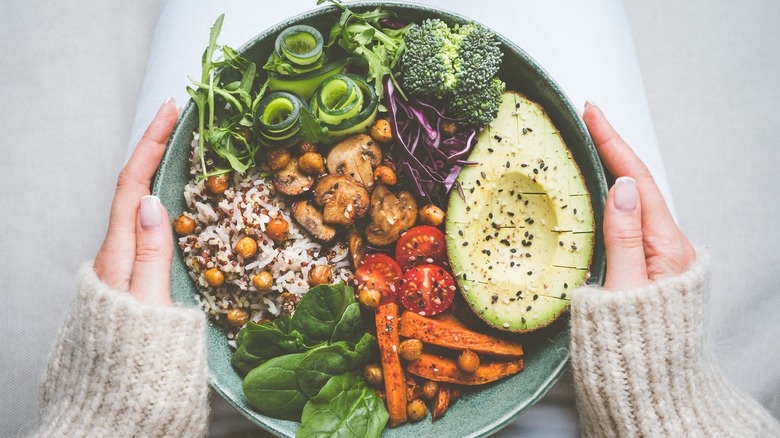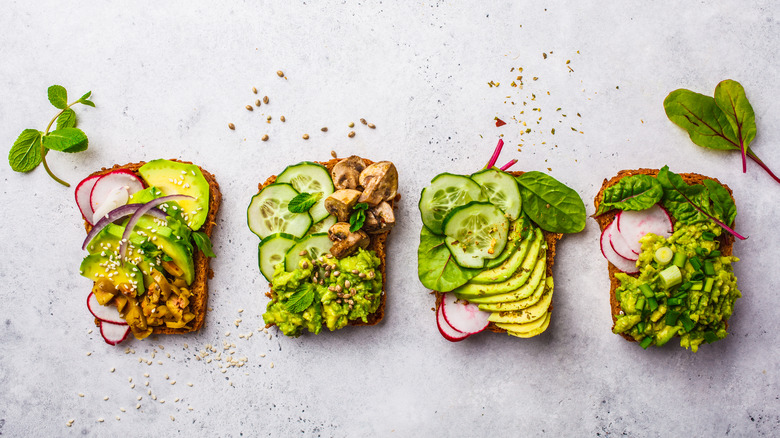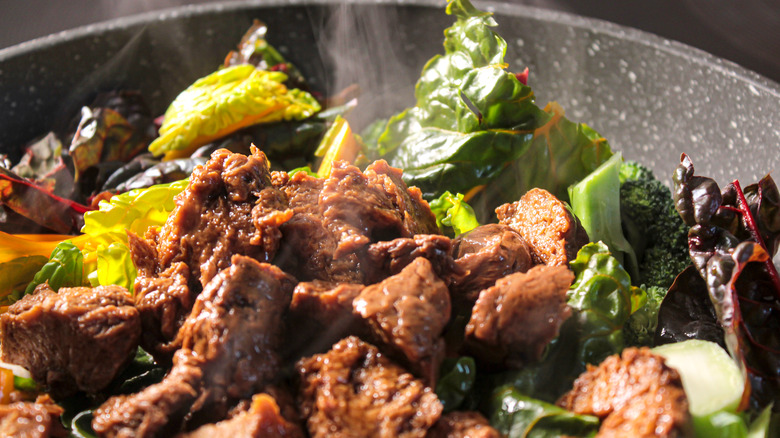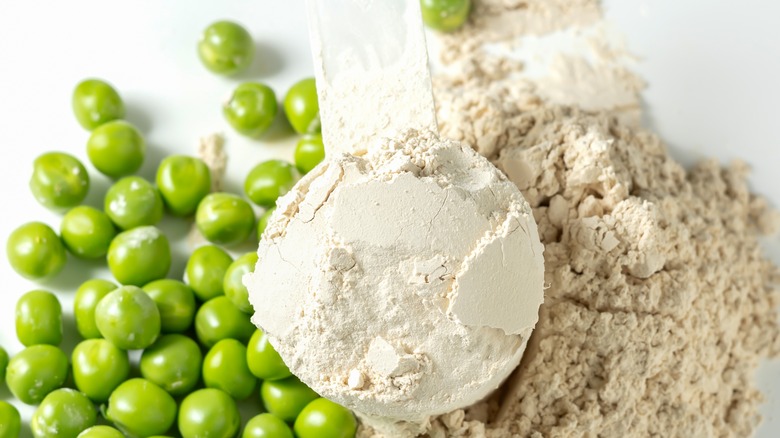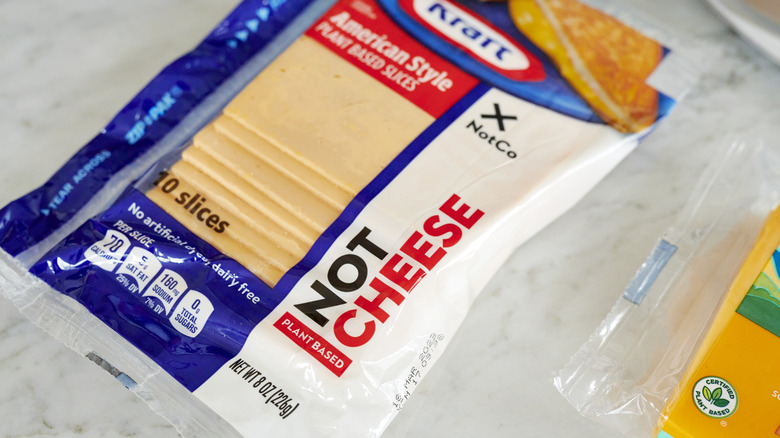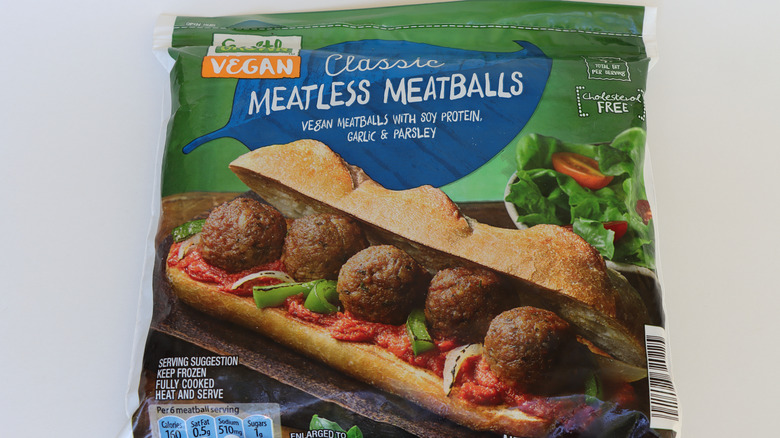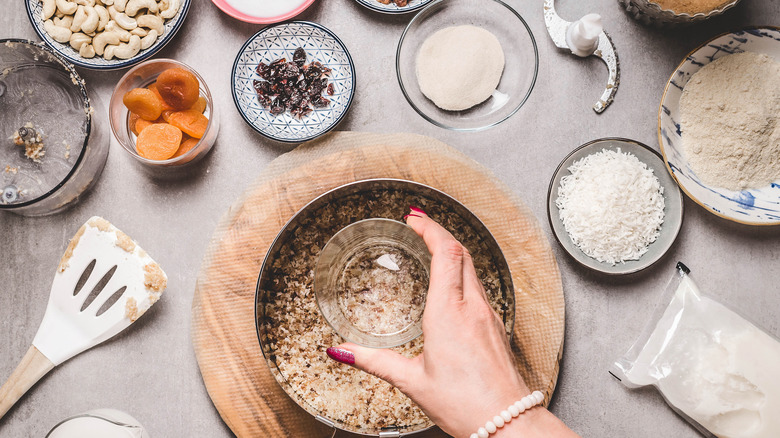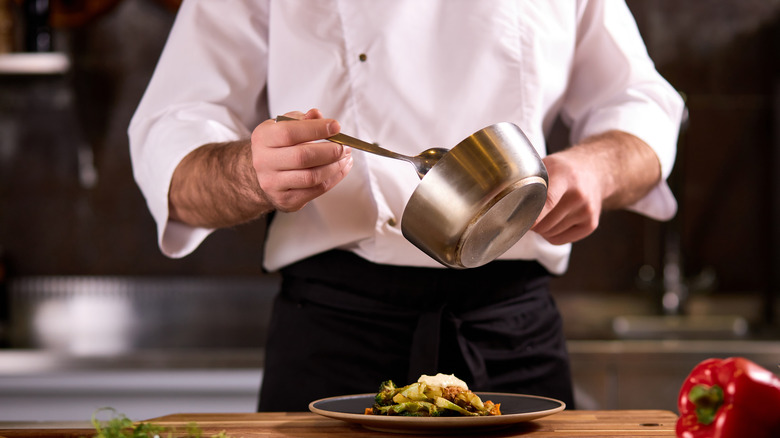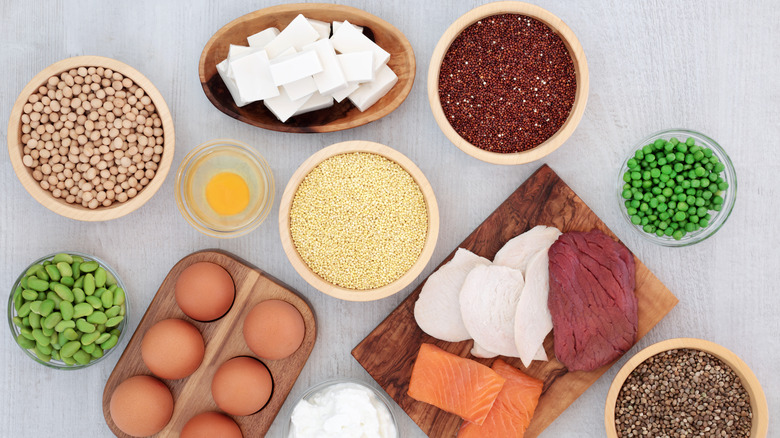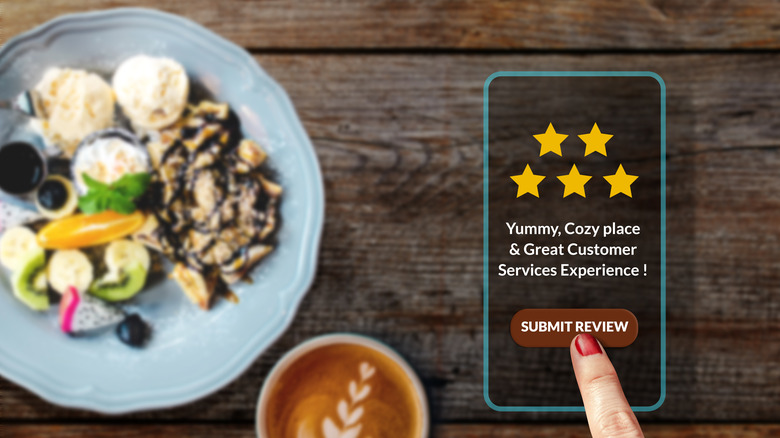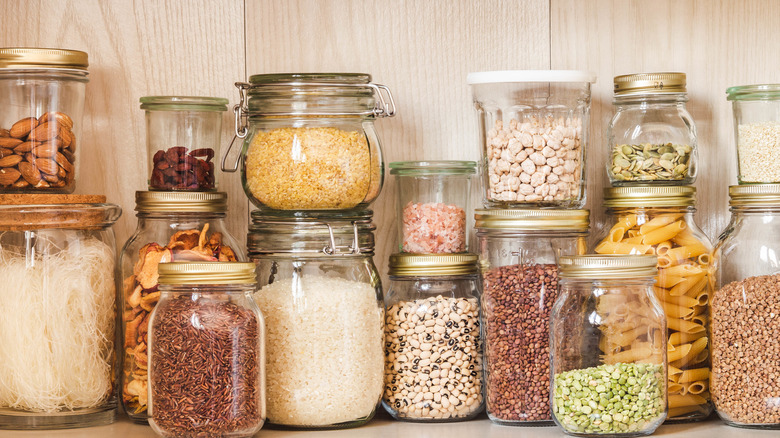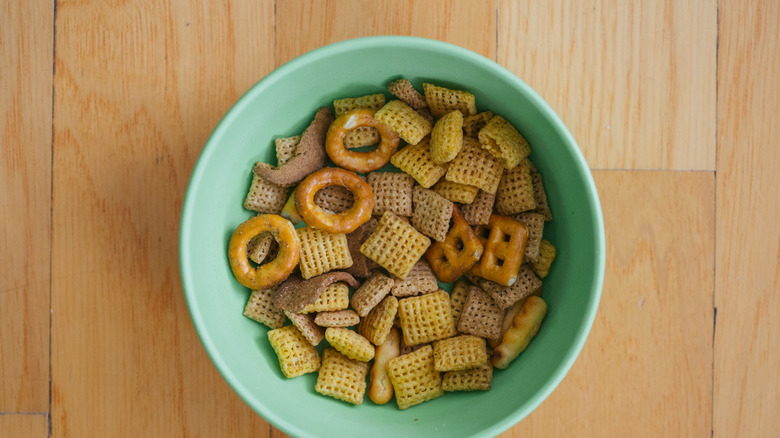15 Tips For Being Vegan In 2023
We may receive a commission on purchases made from links.
Veganuary is one of the largest pushes for people in the world to adopt a plant-based diet; participating members adopt a plant-based diet for the entire month of January. According to its website, 83% of its 2022 Veganuary participants admitted that they plan to uphold dietary changes throughout the year. We should note there is an immense difference in committing to dietary changes for an entire month versus the foreseeable future. The MD Anderson Center at the University of Texas notes major barriers to dietary change, including feelings of deprivation, an "all or nothing" attitude, and feelings of becoming overwhelmed or over-committed, can cause people to drop off from a certain dietary choice.
If you're looking to continue your vegan diet resolutions beyond February 1st, you need to prioritize sustainability. Becoming a full-time plant-based eater can seem like an overwhelming task, but we're here to help. Here are some of our top tips for adhering to a vegan diet in 2023.
Try out the Vegan Before 6 diet
Food writer Mark Bittman may have published "VB6: Eat Vegan Before 6:00 to Lose Weight and Restore Your Health . . . for Good" in 2013, but the sentiments of the book remain true 10 years later. Bittman suggests that folks adopt a plant-based diet only before 6 pm. Once the clock strikes six, you can eat any food, animal-based or not. This dietary structure, Bittman argues, has more flexibility than requiring that folks adhere to a vegan diet all the time. It also allows eaters to enjoy steak dinners with the family or indulge in pre-dinner cheese.
If you're unfamiliar with eating vegan breakfast and lunch, you may have to get creative. Swapping eggs with a tofu scramble seasoned with nutritional yeast and spices is one way to ensure you're getting enough protein while also not missing out on the experience of a classic American breakfast. You can also substitute dairy-based yogurt with almond, oat, or coconut milk yogurt with a sprinkle of honey-free granola.
Use a vegan protein in stir fry or curry instead of meat
Many vegan recipes are veg-forward — including stir fry and curry. Instead of using chicken or beef in your stir-fry recipe, you can make a quick substitution with a vegan protein. There are numerous types of vegan proteins available, some of which are better in certain applications than others. Tofu is one of the most widely available proteins but can have a custard-like consistency that may not appeal to certain palates. Seitan, also known as "wheat meat," is made with vital wheat gluten and resembles the same chewiness of beef with a flavor that can be altered by ingredients, sauces, and purees. If you're looking for a grainy texture with a hefty dose of prebiotic fiber, you may consider adding tempeh to a stir-fry recipe.
There are numerous pre-packaged meat alternatives available on the market if you would prefer to purchase frozen, pre-cooked protein. Gardein is one major retailer that sells frozen chicken-like strips or plant-based pieces that come with a frozen sauce. Just add vegetables and starch, and you are good to go.
Swap out whey protein for a plant-based protein
If you frequent the gym, you may wonder how you'll be able to live without your post-workout protein shake. The good news is, you won't have to.
One simple swap you can make is to use plant-based protein powder instead of whey protein powder. Some of the most widespread options on the market for powders include hemp protein, pea protein, brown rice protein, and soy protein. Commercial plant-based protein powder mixes are usually a combination of these powders (via Healthline) — this helps ensure that the plant-based protein contains all of the necessary amino acids needed to form proteins. The protein content in whey and plant-based powders is around 20 to 30 grams per serving, meaning that you won't miss out on a satisfying post-workout recovery.
Both whey and plant-based protein can be substituted with a 1-to-1 ratio. You can add protein powder to your oatmeal or include the powder in your favorite mug cake recipe.
Embrace vegan cheese
You should add vegan cheese to your list of plant-based products that have come a long way since first being developed. You can purchase vegan cheese in numerous forms, including cream cheese spreads, shreds, snacking cheese, or slices. Some of our favorite brands of vegan cheese include Treeline Cheese. The brand offers numerous artisanal kinds of cheese, including soft-French style cheese, "goat" cheese, and bloomy rind cashew cheese. We found their cream cheese to be just as flavorful as dairy-based cream cheese; it has the same tang with an unctuous, spreadable quality. If you're throwing a party, we recommend adding a container of dairy-free garlic and herbs Boursin cheese spread to your grocery list. This cheese is the perfect blend of salty, savory, and creamy.
If you're looking for cheese that melts on a budget, you can try Aldi's in-house brand: Earth Grown. You'll find both mozzarella and cheddar shreds at this grocery store chain, perfect for melting on a fresh bowl of pasta or on top of a vegan burger.
Find a vegan substitute for your summer BBQ
Summer might feel like a long way from January, but you can always enjoy a vegan protein alternative at your next summer barbecue. The options for vegan burgers and brats are endless in the modern vegan world and can include popular brands like Beyond Meat or Impossible. These burgers are designed to taste and "bleed" like a traditional beef burger. Some people do not like the texture of these burgers — after all, if you're trying to go vegan, you probably don't want anything resembling blood. Instead, you can eat a mixed vegetable to quinoa burger. Many of these veggie burgers are made with flavorful ingredients like beans, edamame, mushrooms, peas, and the like.
If you're a hot dog or sausage person over a burger, you should know that you have numerous vegan substitutes to choose from, such as Meatless Farm and Field Roast. You won't have to worry about sacrificing flavor or meat-like texture with vegan sausage, especially when you can add your own vegan condiments on top.
Follow more vegan creators on social media
Making a monumental change in your life, diet or not, requires the support and creativity of your network. Following vegan creators and influencers on TikTok and Instagram are simple ways to get more recipe ideas and find tips and tricks to make your journey through veganism much easier. The Queer Brown Vegan, Isaias Hernandez, is one of many individuals seeking to educate his following about the intersectional issues of gender, class, and race within the vegan movement. Tabitha Brown is another up-and-coming figure in the vegan world; she most recently released her line of vegan groceries to Target to make veganism more accessible to customers. Brown is also a best-selling New York Times author and hosts Food Network's "It's CompliPlated."
If you don't have an influencer in mind, you can start by using the "search" function on your social media to look for recipes, bloggers, and inspiration. Happy scrolling!
Take time to plan your meals methodically
Structure is the key to sustaining your goals and lifestyle. One way to help guide your newfound dietary choice is to utilize a meal planning structure for your grocery store trips, which will help you branch off into new recipes. One of the most common mistakes people make with meal planning is to stick with batch cooking; this is when someone makes a big serving of a meal to eat at regular intervals throughout the week. Although this can create dietary fatigue, you can remedy this by making batches of single ingredients like pasta, roasted veggies, or grains and peppering them into dishes throughout the week. This cuts down on your cooking time but will keep meals interesting through different sauces and applications. You should also consider what kinds of meals you can freeze or refrigerate for easy meals on the go; some foods, like cooked spinach or roasted asparagus, do not keep as well as others.
You can set a list of vegan meals you feel comfortable cooking and rotate the list throughout the week to start. To keep things simple at first, aim to make at least one new recipe a week.
Keep quick plant-based foods on hand for meals-in-a-pinch
In a perfect world, we would all love to have enough time to cook meals on the day we plan to eat them. But having a few vegan meal staples to have on hand for nights when you don't have the time to run to get the rest of your ingredients is important. Aldi offers several vegan foods that you can keep in your freezer and reheat in a matter of minutes, including dumplings, vegan burgers, and meatless meatballs. Trader Joe's offers similar products, like its Greek Chickpeas with Cumin and Parsley, for no-prep weeknight meal inspirations. You can also purchase vegan mac and cheese from brands like Upton's Naturals, Daiya, or Banza (via Make it Dairy Free) that can be made with the addition of plant-based milk in less than ten minutes.
Although these options may not be the most "healthy" ones, you can spice up your pre-made foods with fresh veggies (or frozen ones), whole grains, and seasoning.
Explore vegan replacements in baking
Vegan baking doesn't require that much creativity — it just requires a bit more flexibility in ingredients. You can purchase plant-based butter that behaves similarly to traditional dairy butter sticks. A great option is Bob's Red Mill Egg Replacer, an ingredient that replaces the same binding function as eggs. In turn, you won't have to fuss with chia seeds, bananas, or applesauce in a recipe — all of which may disrupt the texture of whatever you're trying to make.
One important replacement you'll need to know about when you bake vegan treats is to replace granulated cane sugar with organic sugar, beet sugar, or coconut sugar. In the United States, some granulated sugar is processed with bone char to make it appear more white. Brown sugar, which is granulated sugar with added molasses, can be processed with bone char too. Organic sugar cannot be processed with bone char, so this is an easy way to avoid the question of "bone char or not" entirely.
Support local vegan restaurants
There are likely plenty of great vegan restaurants in your community — you just have to look around to find them. One simple way to find vegan restaurants in your community is by using HappyCow. You can change your search options to look for vegetarian, vegan, or veg-optional restaurants near you and write reviews for restaurants you've already visited.
If you're going to a restaurant that does not have items listed as "vegan" already on the menu, it doesn't do you any harm to confirm the recipe ingredients. Some veggie burgers may include eggs as a binder, so it's always important to confirm with the kitchen that certain items are actually vegan. In turn, this may require you to clarify that you do not eat eggs or dairy products — some restaurants mistake "vegan" for "gluten-free." You can also ask the restaurant staff if meals can be made vegan — it might mean having to substitute some ingredients substitutions or missing out on some parts of the dish.
Understand that its okay to ease into the transition
There is a very important difference between eating vegan for a month versus for the foreseeable future. Switching to a vegan diet without making major considerations for your favorite steak dinner or egg dish may leave you craving certain foods — and, unfortunately, likely to cave and stop eating vegan altogether. If you want to make a more sustainable dietary transition, we recommend taking time to allow yourself to eat your favorite foods. You may make exceptions for special occasions like holidays or your monthly family lasagna night — or allow yourself to eat one vegan meal each day. The amount of flexibility you have is up to you.
If you go from eating an almost entirely meat-based diet to only eating tofu, you will likely struggle more to make the transition. You can build your palate by eating more vegan ingredients like whole grains, tofu, and beans, so you have options once you make the transition.
Seek support from plant-based eaters in your network
You should never feel like you have to make a big life transition alone. Social media sites, like Facebook and TikTok, have opened up more opportunities for connecting folks with similar interests. You can search for key terms like "Vegans in [state]" or "Vegans in [region]" to help connect you to folks who may also be looking for opportunities to meet other plant-based eaters. Not only will this open up networking opportunities, but you can also create a supper club or dinner group or share recipe ideas.
It is equally as important to build connections offline too. Challenge your siblings, significant other, or friends to cook vegan recipes a few times a week. You can also introduce your family to vegan recipes by bringing vegan cookies, soups, and salads to your family gatherings — some of them may not even be able to tell the food are vegan!
Advocate for more vegan options at restaurants
If you want to see more vegan food in your community, letting restaurant owners know that there is a demand is critical. According to Animal Outlook, approaching smaller, family-owned restaurants tend to have more upward mobility than multinational corporations. Consider bringing information about the demand for vegan restaurants in your community, as well as sample products or recipes to help illustrate that vegan recipes can be practical for the scale of the business. You should also plan to discuss the benefits of offering plant-based fare to other dietary observations in the community, such as folks who are allergic to eggs or lactose intolerant.
Adding a negative online review of a restaurant simply because they don't offer niche dietary options is not conducive to creating change; it just brews animosity and often results in the business just taking the review down and going on with their day. You should remember to keep your meeting with the owner cordial, honest — and short.
Stick with the ingredients you're comfortable with before branching out
When it comes to cooking with vegan ingredients, you may struggle to learn how to prepare so many new ingredients so quickly. At first, you should start with the ingredient you enjoy — such as pasta, rice, or nuts. Start pairing the flavors and textures of new ingredients with your vegan pantry staples. Once you learn how to cook ingredients like tofu to your liking, you can pair them with your pantry staples to create whole meals. Once you slowly add new ingredients, you can make an entire meal-planning experience by mixing and matching your pantry staples.
There are some ingredients you'll frequently find in vegan recipes that you should learn early on. Nutritional yeast, for example, is an ingredient that will change the flavors of your vegan recipes forever. Adding nutritional yeast to the sauce will add a distinct cheesy flair, as well as the essential micronutrient known as vitamin B12.
Research and stock up on vegan snacks
If you're going to make it through the other end of your vegan journey alive, you'll have to stock up on snacks. Some conventional snacks you probably didn't know were vegan include classic Chex Mix, Lays Barbecue potato chips, Doritos Sweet Spicy Chili, and Ritz crackers are just four savory snack ideas — most of which you won't have to pay extra for (via PETA). If you're feeling like something sweet, pass through the candy aisle and pick up some Swedish Fish, Sour Patch Kids watermelon chews, and Smarties (via VegNews).
If you like to finish your day with desserts, you can try Marie Callendar's frozen apple pies. We recommend topping your pie with a scoop of vegan ice cream; you can find numerous plant-based ice creams made with almond milk, coconut milk, or oat milk bases in the freezer aisle of your local grocery store.
